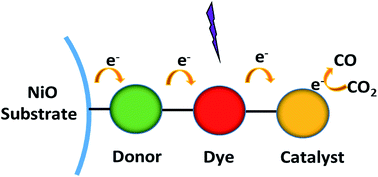A donor-chromophore-catalyst assembly for solar CO2 reduction†
Abstract
We describe here the preparation and characterization of a photocathode assembly for CO2 reduction to CO in 0.1 M LiClO4 acetonitrile. The assembly was formed on 1.0 μm thick mesoporous films of NiO using a layer-by-layer procedure based on Zr(IV)–phosphonate bridging units. The structure of the Zr(IV) bridged assembly, abbreviated as NiO|-DA-RuCP22+-Re(I), where DA is the dianiline-based electron donor (N,N,N′,N′-((CH2)3PO3H2)4-4,4′-dianiline), RuCP2+ is the light absorber [Ru((4,4′-(PO3H2CH2)2-2,2′-bipyridine)(2,2′-bipyridine))2]2+, and Re(I) is the CO2 reduction catalyst, ReI((4,4′-PO3H2CH2)2-2,2′-bipyridine)(CO)3Cl. Visible light excitation of the assembly in CO2 saturated solution resulted in CO2 reduction to CO. A steady-state photocurrent density of 65 μA cm−2 was achieved under one sun illumination and an IPCE value of 1.9% was obtained with 450 nm illumination. The importance of the DA aniline donor in the assembly as an initial site for reduction of the RuCP2+ excited state was demonstrated by an 8 times higher photocurrent generated with DA present in the surface film compared to a control without DA. Nanosecond transient absorption measurements showed that the expected reduced one-electron intermediate, RuCP+, was formed on a sub-nanosecond time scale with back electron transfer to the electrode on the microsecond timescale which competes with forward electron transfer to the Re(I) catalyst at t1/2 = 2.6 μs (kET = 2.7 × 105 s−1).



 Please wait while we load your content...
Please wait while we load your content...